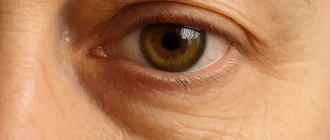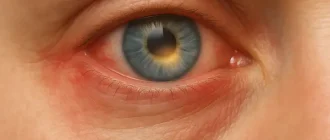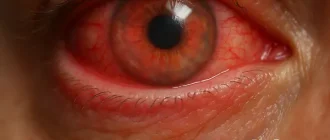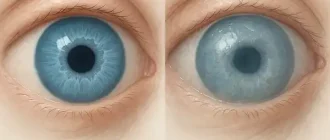Corneal arcus is a condition in which a grayish-white ring forms around the outer edge of the cornea, the clear, dome-shaped surface of the eye. It is a common condition, usually seen in adults over the age of 40. While it is usually harmless, it can be a sign of an underlying medical condition.
Symptoms

Symptoms of corneal arcus include a grayish-white ring around the outer edge of the cornea, blurred vision, and sensitivity to light. In some cases, the ring may be accompanied by a yellowish-white deposit in the center of the cornea.
See also: Blue Ring Around Eye
Causes
The exact cause of corneal arcus is unknown, but it is believed to be related to high levels of cholesterol in the blood. Other risk factors include age, family history, diabetes, high blood pressure, and smoking.
See also: What Causes Yellow or Brown Rings Around Pupils?
Diagnosis
Diagnosis of corneal arcus is usually done through a comprehensive eye exam. During the exam, the doctor will look for signs of the condition, such as the grayish-white ring around the cornea. The doctor may also use a slit lamp to look for deposits in the center of the cornea.
Treatment
Treatment for corneal arcus is usually not necessary, as the condition is usually harmless. However, if the condition is caused by an underlying medical condition, such as high cholesterol, the doctor may recommend medications or lifestyle changes to help manage the condition. In some cases, surgery may be recommended to remove the deposits in the center of the cornea.
Good to know: What is Aphakia
Prevention
Prevention of corneal arcus is not possible, as the exact cause is unknown. However, it is important to maintain a healthy lifestyle, including eating a balanced diet, exercising regularly, and avoiding smoking.
FAQ
What does corneal arcus indicate?
Corneal arcus is typically a symptom of elevated blood cholesterol levels. Although it can happen to younger people as well, it is more frequently seen in adults over the age of 50. It may occasionally be a symptom of a hidden medical issue, including diabetes or renal illness.
Is arcus senilis serious?
Arcus senilis rarely causes harm and doesn’t need to be treated. If you experience this illness, it’s crucial to have your cholesterol levels examined because it may be an indication of excessive blood cholesterol levels.
What layer of cornea is Arcus?
The cornea’s outermost layer, the corneal epithelium, is where one may find the corneal arcus. It appears as a ring around the cornea’s margin that is either gray or white.
How do you reduce corneal arcus?
Corneal arcus is typically not harmful and doesn’t need to be treated. However, lowering your cholesterol levels might aid in lessening the arcus’ appearance if it is brought on by excessive blood cholesterol levels. You may lower your cholesterol levels by eating a nutritious diet, exercising frequently, and using cholesterol-lowering drugs.
Is corneal arcus rare? How common is corneal arcus?
A rather frequent condition, particularly in elderly persons, is corneal arcus. Up to 40% of adults over 50 are thought to have corneal arcus to some extent.
What does cholesterol in eyes look like?
A gray or white ring can be seen around the cornea when there is cholesterol in the eyes. Arcus senilis, also known as corneal arcus, describes this.
Can doctors tell if you have high cholesterol by looking at your eyes?
Yes, medical professionals can determine whether you have high cholesterol by looking at your eyes. It is likely that you have high blood cholesterol levels if you have corneal arcus.
How do I remove cholesterol from my eye?
The eye cannot be cleansed of cholesterol. However, if cholesterol is what is causing your corneal arcus, lowering your cholesterol levels may be able to help you get rid of the arcus. You may lower your cholesterol levels by eating a nutritious diet, exercising frequently, and using cholesterol-lowering drugs.
Conclusion
Corneal arcus is a common condition that usually does not require treatment. However, it is important to be aware of the symptoms and risk factors, as it can be a sign of an underlying medical condition.





